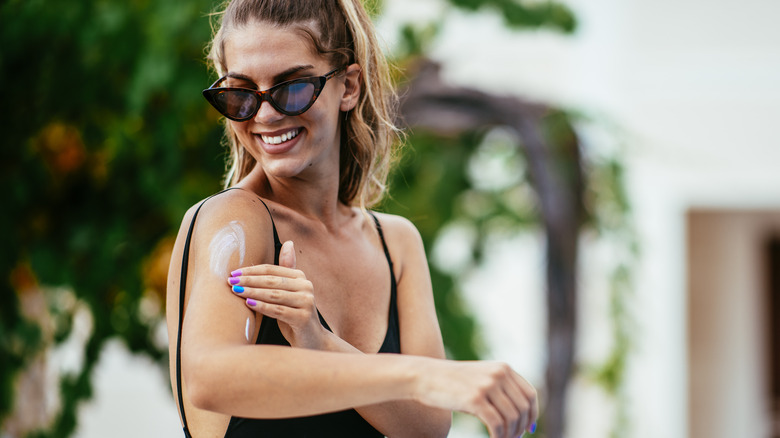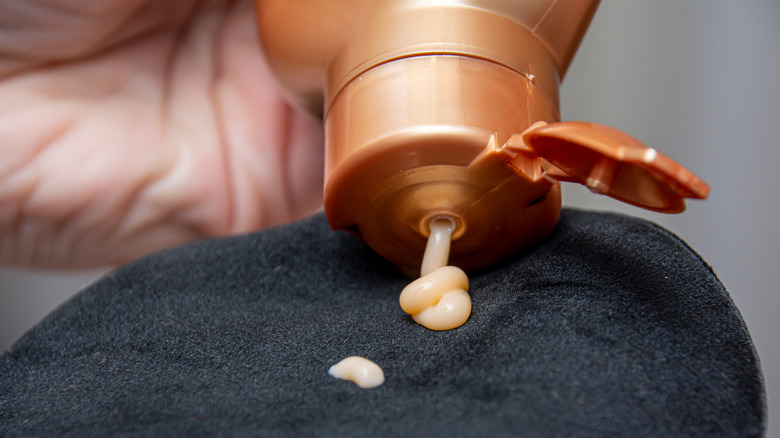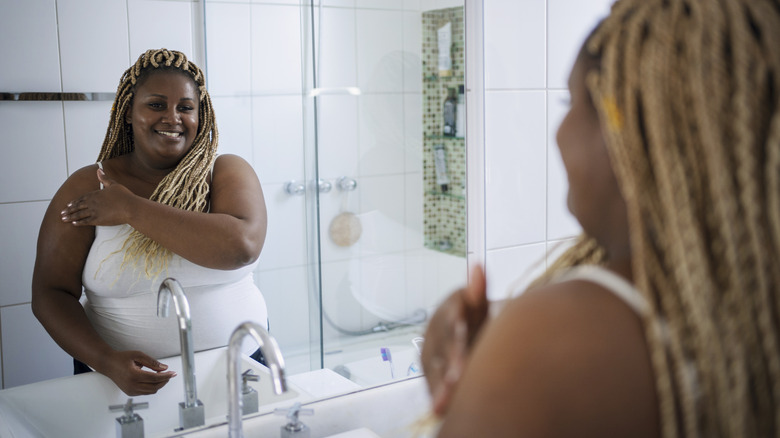JSYK, Self-Tanner Doesn't Double As SPF
Even when it isn't the middle of summer and the sun isn't blazing, the benefits of sunscreen can't be understated: By wearing a minimum of SPF 15 sunscreen, you can reduce your chances of developing skin cancer as well as precancer skin conditions. However, some people still choose to skip the sun protection. Their reasons vary, but many people assume that their other skincare products and cosmetics, such as self-tanner, provide them with enough coverage. Unfortunately, this is a long-standing myth that can burn you — literally.
While your self-tanner is a safer way of achieving a sun-kissed glow than alternatives like tanning beds and outdoor tanning, it doesn't replace the protection that comes from broad-spectrum sunscreen. Per the Skin Cancer Foundation, this type of sunscreen is essential for protecting the skin from damage as a result of the sun's ultraviolet (UV) rays. Furthermore, using it daily can help reduce the development of age spots, skin discoloration, and wrinkles.
Some people assume that when their skin is darker as a result of self-tanner, they have a built-in layer of protection against the rays of the sun. But unless the product you're using explicitly states that it provides broad-spectrum SPF, your self-tanner isn't the saving grace you thought it might be. In fact, you can still tan — and burn — underneath the self-tanner on your skin. Knowing how self-tanner works can help you understand why and give you a better idea of how to protect yourself.
Why self-tanner won't shield you from the sun
Self-tanner typically works on the skin because it includes an ingredient known as dihydroxyacetone, or DHA (per the Skin Cancer Foundation). This interacts with the amino acids within the skin, resulting in darkening. However, this is not the same process that the skin undergoes when it is exposed to UV rays.
UVA rays, in particular, create a tan within your skin by oxidating the melanin in it — a different type of chemical reaction that also results in a darker color — whereas UVB rays create a tan by increasing your body's production of melanin within the skin. Both types of rays penetrate your skin, but UVA rays are known for penetrating as far as the middle layer (dermis). Tanning lights and tanning beds also give off UV rays and evoke these same chemical reactions within the body — meaning that they are not any safer than tanning under the sun, and you experience the same health risks.
Even if your tan is from a less-harmful method like self-tanner, it does not provide adequate sun protection. Darker skin alone doesn't fend off the effects of the sun's rays. Broad-spectrum sunscreen does — and if your self-tanner doesn't come with the appropriate level of protection, you're not covered. While there is a small SPF boost that comes with base tanning, this is often misinterpreted and doesn't do much toward what you need to be protected.
Protection beyond the base tan
By all means, get your sun-kissed glow from a self-tanner before you go outside, but don't expect it to act like SPF. According to Harvard Health, getting a "base tan" only provides a modest amount of protection — experts believe that it's equivalent to about an SPF 3 or 4 sunscreen. While this technically means you've bought yourself time before you begin to burn under UV rays, it doesn't mean you're shielded from their harmful effects if you choose to spend all day under the sun. It may seem like a better option than relying on a self-tanner without any SPF, but if you truly want protection, broad-spectrum sunscreen is key.
In addition to ensuring that your sunscreen covers all UV rays, it's best to do your due diligence by verifying it's SPF 30 or higher — this is the most recent recommendation from the American Academy of Dermatology Association. Be sure to reapply your sunscreen as necessary throughout the day, no matter how dark your "base tan."
If you don't have your sunscreen but need to be outdoors, do your best to stay in the shade, especially when the sun is strongest between 10 a.m. and 4 p.m. Clothing can also help shield your skin from UV rays, and some items are even created to provide sun protection — look for UPF on tags to understand their level of protection.


